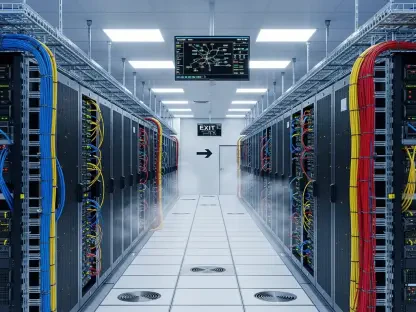The Global Cloud Data Loss Prevention (DLP) Solution Market is poised for significant growth, driven by technological advancements, increasing data security awareness, and stringent regulatory requirements. This article delves into the future trends and outlook of the market up to the year 2032, leveraging a comprehensive analysis to provide valuable insights.
Analytical Approaches and Market Overview
The comprehensive analysis of the Cloud DLP market employs multiple analytical techniques, including PESTL and SWOT analyses. These methodologies offer a 360-degree view of the market environment.
The Role of PESTL Analyses
PESTL analyses, which examine Political, Economic, Social, Technological, and Legal factors, are crucial in understanding the macroeconomic variables affecting the Cloud DLP market. Political stability and regulatory frameworks, for instance, significantly influence market trends and adoption rates. Technological factors point to rapid innovations and the increasing integration of cloud solutions in various sectors. Economic elements emphasize market opportunities and challenges, driven by global financial conditions. These comprehensive insights are essential for stakeholders aiming to gauge the market’s potential and strategize accordingly.
Social factors reveal shifts in consumer behavior and organizational practices, including the growing emphasis on data privacy and security. Legal aspects focus on the impact of regional legislation on data protection and cybersecurity requirements. Altogether, PESTL analyses offer a nuanced understanding of the market’s external environment, helping companies navigate complexities and make informed decisions. By understanding these macroeconomic variables, businesses can better position themselves to leverage opportunities and minimize risks associated with the volatile nature of the global market.
Insights from SWOT Analyses
SWOT analyses provide an in-depth look at the strengths, weaknesses, opportunities, and threats faced by the Cloud DLP market. Strengths and weaknesses typically focus on internal facets of companies participating in the market, such as technological capabilities and resource allocation. Opportunities and threats, on the other hand, offer a broader perspective by evaluating external factors that could influence market dynamics. This dual approach enables stakeholders to fortify their strengths while addressing operational weaknesses. For example, companies with robust R&D departments can capitalize on emerging trends and technologies.
This analysis helps businesses identify gaps in their strategies and prepare for potential challenges from competitors or market shifts. Additionally, SWOT insights drive innovation, encouraging companies to adapt to the changing landscape proactively. By focusing on actionable plans derived from SWOT analyses, businesses can make strategic investments and partnerships that improve their market positioning. It also aids in addressing vulnerabilities by implementing strategies to mitigate risks, ensuring sustainable growth and resilience in the face of market fluctuations.
Market Segmentation
The Cloud DLP market is segmented by type, application, and region, offering a detailed view of its diverse landscape.
Segmentation by Type
The market is primarily divided into On-premise and Cloud-Based solutions. This segmentation highlights the varying infrastructure preferences and deployment strategies adopted by companies. On-premise solutions offer control and customization, allowing organizations to tailor DLP systems to their specific needs and data environments. These solutions are often preferred by companies with stringent security policies or those operating in regulated industries. However, the high cost and maintenance requirements can be a drawback, particularly for smaller enterprises.
On the other hand, Cloud-Based solutions provide scalability and flexibility, making them attractive for a wide range of businesses. These solutions are typically easier to deploy and manage, reducing the burden on internal IT teams. Additionally, cloud-based DLP systems offer enhanced disaster recovery capabilities and are often more cost-effective, particularly in terms of upfront investment. The increasing adoption of hybrid cloud environments is also driving the demand for cloud-based DLP, as organizations seek to secure data across multiple platforms and services.
Segmentation by Application
Applications of Cloud DLP solutions span various sectors, including Retail, Manufacturing, Energy, and Transportation. Each sector experiences unique challenges and benefits from adopting Cloud DLP, with retail and manufacturing showing particularly high adoption rates due to their extensive data handling needs. In the retail sector, the need to protect customer data and transactional information is paramount. Cloud DLP solutions help retailers comply with data protection regulations, prevent data breaches, and maintain customer trust.
In the manufacturing sector, Cloud DLP solutions safeguard intellectual property and proprietary information, which are critical assets. The energy sector, with its complex data structures and critical infrastructure, also relies on DLP solutions to ensure operational security and data integrity. In the transportation sector, securing data can be vital for operational efficiency and safety. Each of these applications demonstrates the versatility and importance of Cloud DLP solutions across different industries, highlighting the universal need for robust data protection strategies.
Geographical Insights
The global market is geographically segmented into several key regions, each exhibiting distinctive characteristics.
North America
North America leads the market in Cloud DLP adoption, driven by substantial consumer demand and high technological adoption rates. The region’s advanced digital infrastructure and regulatory landscape further propel the growth of Cloud DLP solutions. Tech-savvy enterprises and a highly competitive market environment in the U.S. and Canada are significant contributors to this dominance. Additionally, North America’s strong focus on digital transformation and cloud computing accelerates the adoption of DLP technologies.
Regulatory frameworks such as the California Consumer Privacy Act (CCPA) and the Health Insurance Portability and Accountability Act (HIPAA) impose stringent data protection requirements, fueling the necessity for robust DLP solutions. With major tech companies headquartered in North America, the region also benefits from a rich ecosystem of innovation and partnerships. Continuous advancements in AI, machine learning, and data analytics further enhance the capabilities and adoption of Cloud DLP solutions in this region.
Europe
Europe stands out for its innovation and stringent data protection regulations. These factors make it a significant market for high-end Cloud DLP services, as companies strive to comply with rigorous standards. The General Data Protection Regulation (GDPR) plays a pivotal role in driving investment and development in the Cloud DLP market. Businesses in Europe prioritize data security measures to align with compliance requirements, creating demand for advanced DLP solutions.
European companies are early adopters of cutting-edge technologies, including AI and blockchain, integrating these innovations into their DLP strategies. The region’s focus on privacy and security influences global standards, positioning Europe as a leader in data protection. Moreover, cross-border collaborations within the European Union drive standardized practices and foster a competitive market landscape. As a result, Europe continues to push the boundaries of Cloud DLP technology, setting benchmarks for other regions to follow.
Technological and Regulatory Drivers
Technological and regulatory factors are pivotal in shaping the future of the Cloud DLP market.
Technological Advancements
Continuous technological advancements drive the market, enabling Cloud DLP solutions to evolve and meet the demands of dynamic IT environments. Innovations in AI, machine learning, and encryption technologies enhance the effectiveness and adoption of these solutions. AI-driven algorithms offer advanced threat detection capabilities, automating the identification and prevention of data breaches. Machine learning models adapt to emerging threats, providing real-time insights and actionable intelligence for better data protection.
Encryption technologies continue to evolve, offering more robust methods to secure data in transit and at rest. These advancements ensure that Cloud DLP solutions remain resilient against sophisticated cyber threats. The integration of blockchain technology also provides an added layer of security, ensuring data integrity and transparency. As organizations increasingly rely on cloud services, the demand for advanced Cloud DLP solutions will continue to rise. The ongoing technological evolution ensures that these solutions are well-equipped to handle future challenges and complexities.
Impact of Regulatory Frameworks
Regulatory frameworks, particularly those in regions like Europe, significantly impact the Cloud DLP market. Strict data protection laws create opportunities for companies to develop robust solutions that ensure compliance, thereby gaining a competitive edge. Compliance with regulations such as GDPR and CCPA necessitates the implementation of comprehensive DLP strategies, driving market growth. These regulations mandate stringent data protection measures, prompting businesses to invest in advanced DLP technologies.
Failure to comply with these regulations can result in substantial fines and reputational damage, underscoring the importance of robust data protection frameworks. Regulatory requirements also drive innovation, as companies develop new features and capabilities to meet compliance standards. Additionally, harmonized regulations across regions facilitate the adoption of global best practices. As data protection laws continue to evolve, the Cloud DLP market will remain dynamic, influenced by changing regulatory landscapes. Companies that proactively address compliance requirements will be well-positioned to succeed in this competitive environment.
Economic and Competitive Landscape
Economic factors and market competition also play crucial roles in the Cloud DLP market dynamics.
Economic Influences
Macroeconomic stability and supportive economic policies contribute to the increased adoption of Cloud DLP solutions. Countries with favorable political environments and proactive economic strategies are likely to experience substantial market growth. Economic policies that prioritize digital transformation and cybersecurity investment create a conducive environment for Cloud DLP adoption. Government incentives and funding for cybersecurity initiatives also boost market growth, enabling businesses to implement advanced DLP solutions.
The global economic landscape influences budget allocations and investment decisions, impacting the pace of technological adoption. Economic stability fosters business confidence, encouraging enterprises to invest in robust data protection measures. Conversely, economic downturns may slow down adoption rates as companies tighten budgets. Therefore, understanding economic influences helps stakeholders forecast market trends and make informed investment decisions. Overall, macroeconomic factors play a crucial role in shaping the Cloud DLP market, influencing both opportunities and challenges.
Key Market Players
Major players in the market, including Netskope, Broadcom, Cisco Systems, and Microsoft Corporation, shape the competitive landscape. These companies drive innovation through technological advancements and strategic partnerships, influencing overall market trends. Industry leaders leverage their resources and expertise to develop cutting-edge DLP solutions, meeting the evolving needs of diverse sectors. Strategic collaborations with cloud providers, cybersecurity firms, and regulatory bodies enhance their market positioning and customer reach.
Innovation is a key differentiator, with companies continuously improving their offerings to stay ahead of the competition. Research and development investments lead to the creation of advanced features, such as behavior analytics, automated threat response, and integrated compliance reporting. The competitive landscape is also characterized by mergers and acquisitions, as companies seek to expand their capabilities and market share. By understanding the strategies of key players, stakeholders can identify potential opportunities for growth and collaboration.
Sector-Specific Impact
The implications of Cloud DLP solutions vary significantly across different sectors.
Retail and Manufacturing
In sectors like Retail and Manufacturing, the reliance on extensive data handling necessitates robust Cloud DLP solutions. High adoption rates in these sectors are driven by the need to protect sensitive customer data and intellectual property. Retailers face constant threats from data breaches, necessitating advanced DLP strategies to secure customer information and payment data. The rise of e-commerce further amplifies the need for robust data protection measures, as online transactions become more prevalent.
Manufacturers, on the other hand, need to safeguard trade secrets, patents, and industrial designs. Cloud DLP solutions help them secure supply chain data, prevent intellectual property theft, and maintain competitive advantage. The integration of IoT devices in manufacturing processes adds another layer of complexity, requiring comprehensive DLP strategies to secure interconnected systems. By addressing these sector-specific challenges, Cloud DLP solutions enable businesses to operate securely and efficiently.
Energy and Transportation
The Energy and Transportation sectors also benefit from Cloud DLP solutions by ensuring data protection and operational efficiency. In the energy sector, DLP solutions secure critical infrastructure data, preventing unauthorized access and potential cyberattacks. The transportation sector relies on DLP to protect sensitive information related to logistics, passenger data, and operational systems. As these industries become more digitized, the role of Cloud DLP in maintaining data security and compliance becomes increasingly important.









